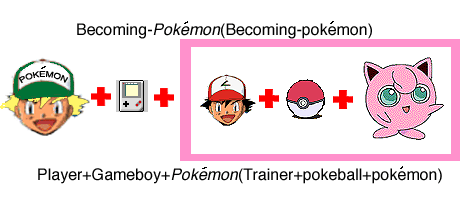This illustration was snatched from the following website: http://www.lclark.edu/~soan370/mythdiagram2.html
2.In the videogame versions of Pokémon, there are 15 different types which have advantage and weaknesses relative to other types. The chart below and its explanation are from the "Oak Files," Nintendo's official online strategy guide:
There are 15 major types of Pokémon, and each type has specific strengths and weaknesses. To find out how one type of Pokémon will do in battle against another, refer to the chart below.
Pokémon Types
1: Normal 2: Fire 3: Water 4: Electric 5: Grass 6: Ice
7: Fighting 8: Poison 9: Ground 10: Flying 11: Psychic 12: Bug
13: Rock 14: Ghost 15: DragonOn the left side of the chart, look for the type that corresponds to your Pokémon. On the top of the chart, look for your opponent's type. From your type, trace a line to the right, and from your opponent's type, trace a line going down.
Look at the symbol in the space where the lines meet. This will tell you whether you have a great chance, a good chance, a poor chance or no chance at all of winning the battle. For example, a Fire-type (#2) will have a great chance again a Bug-type (#12), but a poor chance against a Rock-type (#13). Use this chart to plan your battle strategies.
The "Oak Files" are available online at: http://www.pokemon.com/games/games_02c10.html
3. Fredric Jameson's Postmodernism, or, the Cultural Logic of Late Capitalism discussed the way in which "postmodern" aesthetics are brought about by and are expressions of contemporary economic conditions. As an outgrowth of a globalizing marketplace that can no longer manage inconsistencies, postmodern culture is erratic, cut-up, and ambiguous. As a "worldview" or cultural system, the postmodern condition also provides fertile ground for greater economic penetration as identities and tastes proliferate alongside new marketing and distribution strategies. The result is a rapid acceleration of change as consumer needs, cultural innovations, and an eager marketplace feed each other. Jameson describes the ways in which a consumer culture run amok has "jumped the track" and generated our unique historical situation:
So I come to my principal point here, that this latest mutation in space—postmodern hyperspace—has finally succeeded in transcending the capacities of the individual human body to locate itself, to organize its immediate surroundings perceptually, and cognitively to map its position in a mapable external world. It may now be suggested that this alarming disjunction point between the body and its environment—which is the initial bewilderment of the older modernism as the velocities of the spacecraft to those of the automobile—can itself stand as the symbol and analogon of that even sharper dilemma which is the incapacity of our minds, at least at present, to map the great global multinational and decentered communicational network in which we find ourselves caught as individual subjects. (44)
"Postmodern hyperspace" then, is a new spatial organization (which is a disorganization) or a "smooth space" in which rapid economic growth spurred by consumer quests for "self-actualization" can flourish without borders. As Jameson correctly points out, modernist machinery, "which represent[s] motion" is being replaced by postmodern machines which can only be "represented in motion" (45). However, it is through these new machines, in motion, that "our minds" are learning strategies of mapping "the great global multinational and decentered communications network." In other words, at least some of the concerns which Jameson expresses can be answered in games and toys which are constructed of the materials of this new space and time. How these transformations will effect "humanity," however, remain to be answered.

Velocity(v) is equal to the change in distance(d) over the change in time(t).
The equation for acceleration:

To compute acceleration, velocity occupies the "distance" position of the velocity equation. In other words, distance is to velocity what velocity is to acceleration. In a virtual world, where distance or space is of little importance next to the speed of information transfer, speed is the "distance" and rates of "acceleration" are the new velocity. In this scheme, the rate of change is vector of progress, rather than the steady pursuit of a goal. This situation resembles Moore's Law, which states:
The observation made in 1965 by Gordon Moore, co-founder of Intel, that the number of transistors per square inch on integrated circuits had doubled every year since the integrated circuit was invented. Moore predicted that this trend would continue for the foreseeable future. In subsequent years, the pace slowed down a bit, but data density has doubled approximately every 18 months, and this is the current definition of Moore's Law, which Moore himself has blessed. Most experts, including Moore himself, expect Moore's Law to hold for at least another two decades. ("Moore's Law")
To put it plainly, the rate of technological change has created a sort of "Moore's Law of Cultural Change" for an information economy.
5. A diagram of "becoming-becoming-pokémon."

The pink section of the diagram illustrates the process of becoming-pokémon through the trainer-pokeball-pokémon assemblage. One level above this assemblage is the process of becoming-Pokémon through the player-gameboy-Pokémon assemblage. Since the process of becoming-Pokémon involves playing the game which consists of a narrativized version of becoming-pokémon
6. According to an ABCNews online article from March 28, 2001:
Saudi Arabian authorities have decreed that there's no place for the imaginary, superpowered creatures that make up the Pokémon universe in the Islamic state. The country's highest religious authority issued a fatwa against Pokémon cards and games.Accusing the immensely popular game of "possessing the minds" of children while promoting Zionism and gambling, Saudi Arabia's Higher Committee for Scientific Research and Islamic La issued the fatwa, or religious verdict, this weekend.
The entire article is available online at: http://abcnews.go.com/sections/world/DailyNews/pokemon010326.html